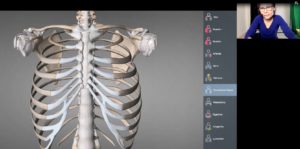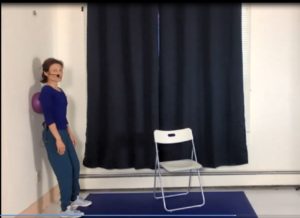
Photo by Genny Pinzon
[ID: Somatic movement practitioner Diana Lara has brown hair and light brown skin and she is wearing a headset, black t-shirt, and black stretchy pants. She is looking down and holding a green ball against the sacrum of a spine model.]
I lived my first three years of life in Tegucigalpa, Honduras with my maternal grandmother. She raised my sister and I while my parents lived in another city raising my other three siblings. Parenting of grandchildren is one of the many situations older adults face. It demands multiple skills and staying on top of their physical and mental health. Access to community resources and support is more needed than ever, and some seniors are lucky to find that at On Lok 30th Street Senior Center.
I am also lucky to work there because I get to lead movement and somatic classes for older adults from underserved communities. The center was created 43 years ago by a group of Nicaraguan seniors in the Mission District (225 30th Street) in San Francisco. In 1995 30th Street became part of On Lok, a full-service healthcare program. The center serves around 7000 older adults, and offers meals, informational resources, activities, and movement classes to a vibrant, racially and culturally diverse community.
Incorporating somatics into the senior center
On Lok 30th Street Senior Center offers a variety of movement programs:
- A multi-component exercise drop-in class from Monday to Friday, 10:00-11:00 am. This class has been offered since 2007 at multiple sites in San Francisco, and it is focused on cardio-respiratory endurance, muscle strengthening, balance, and flexibility.
- A 12-week fall prevention program, to help reduce fall risk among older adults.
- A 10-week tai chi for arthritis program that we started offering last year. The program is based on tai chi Sun style. It is an evidence-based program created by the Tai Chi for Health Institute.
- And a new 10-week somatic movement for spine mobility and posture program that I designed and I am teaching and evaluating at this time.

[ID: Screenshot from an online somatic education class that shows an anatomical image of a frontal view of the ribcage with bones and connective tissue. The instructor Diana Lara is a Latinx woman wearing a purple t-shirt who appears in a small square in the upper-right corner of the screen.]
In March 2020, we moved our programs to an online format to comply with the mandated shelter-in-place. We were happily surprised by how our participants continued attending the movement classes and programs in the new online format.
During the last two years we have expanded the movement offerings by adding approaches to movement that emphasize breathing, alignment, and sensory awareness. As a registered somatic movement educator with a certification in developmental movement from The School of Body-Mind Centering®, I noticed that some participants were putting a lot of emphasis on developing leg and arm strength and mobility, but very low attention to the alignment, posture, and movement of their torso. I wanted to fill that gap by offering the somatic movement program with emphasis on the movement of the spine and posture. I was motivated to launch this program in order to bring somatic education to older adults who have not been exposed to it and/or face barriers to access it.
Why somatics matter
Research shows that we lose spine mobility as we age, and this impacts activities of daily living such as sitting to standing, getting in and out of the car, climbing stairs, lifting objects and driving, among others.[1] Also, the lack of spine, shoulder, and hip flexibility impairs posture and balance, increasing risk of falling.[2] Although the aging process reduces mobility, somatic education brings awareness of posture and maladaptive movement patterns and therefore leads to a more functional and expressive body.
Soma was defined by Thomas Hanna in the 1960s as the living body that perceives from within by first-person perception, and regulates itself in relationship with the physical and social environment.[3] There are many somatic education methods that have been developed in the nineteenth and twentieth century. One of them is Body-Mind Centering® (BMC).
BMC uses guided imagery based on anatomical and physiological properties of the body systems: skeleton, ligaments, muscles, fascia, fat, skin, organs, endocrine glands, nerves, and fluids.[4] The information is delivered by different channels including a) visual images such as drawings, anatomical software, and models, b) auditory information through guided journeys, sounds and music, and c) self-touch or touch by another person using hands or props such as balls, bands, fabrics.[5] The information is processed and/or expressed by the participant in stillness, movement, breath patterns, vocal sounds, and self-touch or touch to other participants. Some practitioners include other types of processing and expression such as writing or drawing.
Filling the somatics gap

[ID: Screenshot from an online class that shows instructor Diana Lara, a Latinx woman, pushing a small inflatable ball that is placed between her shoulder blades against a wall to provide awareness to the upper torso. She is in a room with white walls, black curtains covering a window, and a folding chair. She wears a headset and looks towards the camera.]
There are some exercise programs for seniors that specifically target spine mobility delivered by physical therapists in clinics and hospitals. But there are no group programs offered in San Francisco at the community level that target spine mobility and posture for seniors based on somatic techniques.
I started offering the somatic movement program during the summer of 2020 when we transitioned all our programs to an online format. I had already designed the curriculum to offer in person. At the beginning I was hesitant to offer the program online. I thought it would be too difficult to foster body awareness and repatterning while you are watching a screen or listening to the words of an instructor who is not in the same room.
On the other hand, the pandemic provided an opportunity for us movement facilitators to reach out to older adults who have transportation or other logistical barriers to come to the center. Plus, I was eager to share the BMC-based curriculum that I had developed. So, I decided to launch the Somatic Movement for Spine Mobility and Posture online pilot program, with the support of On Lok 30th Street Senior Center.
Multiple components of BMC practice could impact spinal mobility such as developmental patterns. For example, one of these patterns is the spinal yield-push and spinal reach initiated from the head and from the coccyx. The visualization, embodiment, and practice of the spinal pattern, creates a sensation of elongation and strength in the spine. Moreover, BMC brings attention to the vertebras of the spine as well as other tissues in proximity with the bones, such as organs, vertebral discs, ligaments, and the spinal cord. Metaphorical and anatomical images, and awareness of different types of tissues, could facilitate mobility of the spine in the three planes of motion.
BMC exercises conducted slowly and with attention to sensory information could provide the necessary body awareness to repattern maladaptive movements that lead to spine rigidity, pain, and reinforce bad posture. Moreover, slow movement could improve the activation of Type I fiber muscles, or “slow twitch” muscles, that are associated with maintaining posture.
Positive feedback
I offered two pilot programs, one in the summer of 2020, and another in the winter of 2021. Each of them followed the same curriculum and had a duration of six weeks. I was very surprised by the number of seniors desiring to register for the program. I had an average of 36 participants in each of the 12 classes. I invited participants to share their opinions at the end of each program. Here is one of their testimonials:
“This is my first experience in somatic movement… It is educational in understanding the anatomy and spinal structure and the engagement of the body and mind as I move through the motion. It is also relaxing.”
For me, it was very rewarding to share this information with people who have never been exposed to somatics and who were interested in learning more about how to be aware of their posture and movement. Participants wanted to talk about their experiences with somatics and their self-discoveries through explorations. Giving them the space and time to reflect on it was necessary and important.
Benefits of moving online
And guess what…despite my reservations I discovered some positive aspects of teaching somatics online.
First, it creates a private environment for participants to follow their somatic explorations. By allowing them to be more focused on internal motivation rather than external motivations, you discourage competing or comparing their abilities with others. Internal motivation is more beneficial to experience somatics, and the online format might provide support for it.
Second, the online format allowed me to share my screen and show tridimensional anatomy images using the Essential Anatomy app, as well as the spine model. These support materials were one of the features that participants liked more about the class.
Third, the online format might allow frail or house-bound older people to participate in somatics. This population is more likely to be interested in somatics than in more vigorous exercise classes.
At this time, I am offering a 10-week online program at the 30th Street Senior Center. I am delighted to see the participants’ engagement with the material and their willingness to follow somatic explorations, reflect, and share their experience. My gravitation towards seniors, rooted in my grandmother raising me, inspires me to create more opportunities for seniors to practice somatics. I hope to obtain more funding and motivate other somatic educators and dancers to lead older people in transformative experiences and healing processes through movement.
[1]Araújo, C. G. S. D. (2008). Flexibility assessment: normative values for flexitest from 5 to 91 years of age. Arquivos brasileiros de cardiologia, 90, 280-287.
[2]Bergström, G., Aniansson, A., Bjelle, A., Grimby, G., Lundgren-Lindquist, B., & Svanborg, A. (1985). Functional consequences of joint impairment at age 79. Scandinavian journal of rehabilitation medicine.
[3]Hanna, T. (1986). What is somatics? Somatics: Magazine-journal of the bodily arts and sciences, 5(4), 4-8.
[4]Cohen, B. B., Nelson, L., & Smith, N. S. (1993). Sensing, feeling, and action: The experiential anatomy of Body-Mind Centering®. Contact Editions.
[5]Caetano, P. D. L. (2015). For an Aesthetics of Sensations: intense body of Bartenieff Fundamentals and Body-Mind Centering. Revista Brasileira de Estudos da Presença, 5, 206-232.
This article appeared in the Summer 2022 issue of In Dance.


